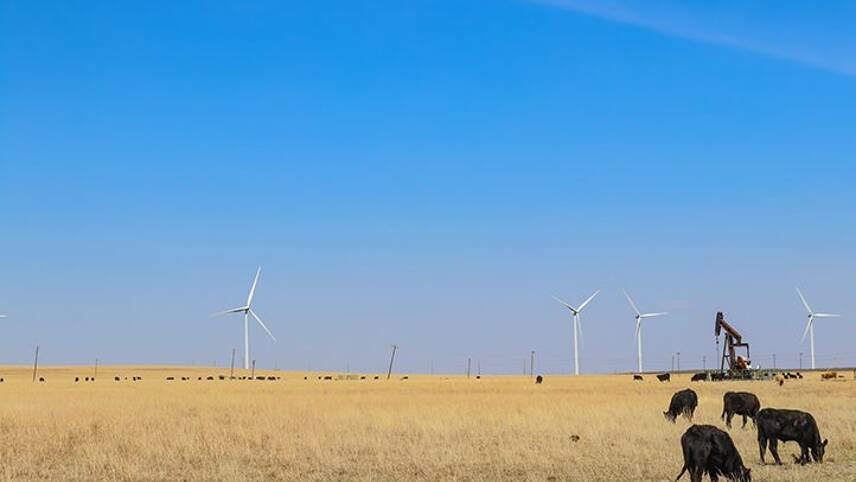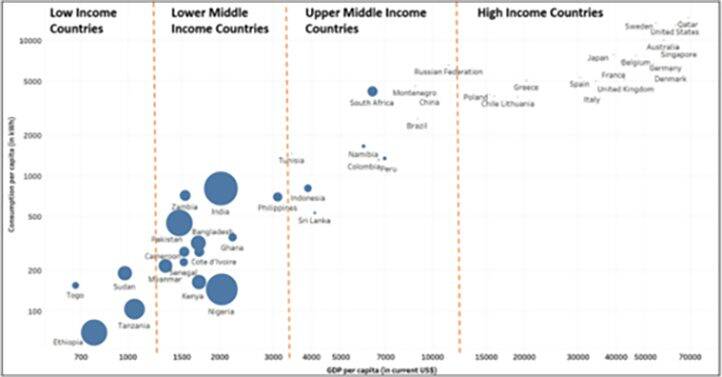Register for free and continue reading
Join our growing army of changemakers and get unlimited access to our premium content

In his seminal essay, Poverty and Famines, Amartya Sen makes a seemingly obvious yet deeply profound statement: “Starvation is the characteristic of some people not “having” enough food to eat. It is not the characteristic of there being not enough food to eat.” He goes on to unpack concepts of democracy, entitlements, and rights as determinants of mass hunger, and addresses the place of the non-poor in a whole-of-society approach to poverty. What Sen was raising in his examination of famines 40 years ago applies to the discourse on climate change today. The question that we must contend with now is the inverse; how do we “include” the poor in our approach to a crisis that was a direct outcome of wealth and consumption?
Until recently, much of the discussion around green energy transitions rightly centered on the role and responsibility of rich nations. The principle of “common and differentiated responsibility” enshrined in the Rio declaration 30 years ago remains essential. At the same time, the dialogue has been somewhat paternalistic, wherein we talk about climate mitigation by the rich countries, and climate adaptation for the poor. We rarely talk about the poor in rich countries, and even less so the rich in poor countries. We need a far more convergent mindset.
The truth is that the battle against climate change cannot be won by a small subset of wealthy nations and progressive global corporations. Today, the world’s energy-poor countries, home to nearly half the global population, account for only slightly above 1% of the global wind and solar generation capacity. Analytical work conducted by The Rockefeller Foundation across 81 energy-poor nations illustrates that even in a best-case scenario for the planet, where high- and middle-income countries achieve their climate pledges, this would not be enough to avoid climate catastrophe. If energy-poor countries rely on fossil fuels for their economic development because of a lack of financing and low levels of technology transfer, their emissions could grow from a 24% global share today to 77% by 2050. Under this scenario, the world will far exceed the 2-degree warming target.
The inability to access and consume reliable power is a massive constraint to opportunity and upward mobility for the world’s poor, 70% of whom are women. A 2021 study conducted by the Oxford Poverty and Human Development Initiative concludes that “electricity is the most interlinked indicator in the global Multi-Dimensional Poverty Index (MPI), and three quarters of the global energy poor are multidimensionally poor…this turns energy poverty in one of the strongest predictors of multidimensional poverty.”
The Energy for Growth Hub has defined the idea of the Modern Energy Minimum, a threshold of 1,000 kilowatt hours of electricity per capita consumption as the minimum viable level needed to drive opportunity and economic mobility. Yet in sub-Saharan Africa today, only five of 46 countries consume above 1,000 kWh per capita, and only South Africa is above 3,000. Put in starker terms, an average American today consumes 27 times more electricity than the average African. As the table below clearly illustrates, there are no high-income, low-energy economies on the planet.
Figure 1: GDP per capita relative to energy consumption per capita
As we look at the intersection of extreme poverty and energy poverty today, the data shows that the two are largely concentrated in the same districts, provinces, and countries around the world. We need to fight poverty in precisely the places where people are living without modern energy. In other words, if we want to end poverty, we must end energy poverty, and the tool to fight both is the same: electrification.
A fascinating new Stanford University-led paper in Ecosphere analyzes energy use in 140 nations from 1971-2018 against nine metrics, including life expectancy, infant mortality, happiness, and economic performance. Their finding that increased energy use and well-being are highly correlated is unsurprising. However, the study reveals that this correlation ends at consumption levels far below the current average in the United States and other wealthy nations.
What this implies is that investing in a clean energy future that increases per capita consumption of electricity for lower- and lower-middle-income nations is going to be necessary if we want to expand human well-being, build societal equality and resilience, and move irreversibly towards a more secure climate future. It is egregious that in the 21st century, hundreds of millions of people – so many of them women and girls – remain locked out of opportunity, and their inability to access and consume sufficient energy is at the heart of the problem. Equally concerning is that at the current rate of progress, 650 million people will still lack access to electricity in 2030, the vast majority of them in Africa.
Unfortunately, recent global crises have put vulnerable populations at even greater risk of being left behind. The Covid-19 pandemic has highlighted and deepened the vast inequities and impacts that come with a lack of access to energy, especially for women. As economies slowly recovered from the impacts of the pandemic, oil and gas prices increased as supply remained constrained – even before the markets were thrown into greater turmoil in the wake of the conflict in Europe. Price spikes have hit consumers at the fuel pump and in the supermarket, with a global food crisis exacerbated by the centrality of natural gas for fertilizer production. Public budgets have not been spared, with rising fuel subsidy costs putting a strain on government accounts in cash-strapped developing economies. Global aid is also being redirected away from energy-poor economies towards the crisis in Ukraine.
For many leaders and citizens in the developing world narratives of a dystopian climate future ring hollow when the present holds so many challenges – from addressing extreme poverty and hunger, to creating jobs for a burgeoning young population, to expanding opportunities for women to participate equally in the economy, or to delivering critical social services in a highly constrained fiscal environment.
But this isn’t a zero-sum game. We must view the ongoing global crisis as an opportunity to take bolder action on clean energy investments that will boost energy security for all. This requires a serious global effort to drive investment and technical support for the design and implementation of comprehensive integrated energy plans in energy-poor countries. Yet last year, Sustainable Energy for All’s Energizing Finance report found that investment for residential electricity in 20 countries home to 76% of the global population without electricity was less than one-third of the $41bn that is estimated to be needed globally per year. Finance also fell dismally short of the $4.5bn required for clean cooking. This must change.
The good news is that the new frontiers of cleaner energy technologies today allow us to unleash an inclusive energy transition that expands access to energy and opportunity for populations that have long been excluded. We are witnessing a remarkable surge in innovation to scale new solutions that address the challenge. Dramatic price reductions and efficiency enhancements in solar, battery, and smart grid technologies are disrupting traditional energy systems. The most profound impact of these developments could be to power the world’s energy poor with clean, reliable electricity via mini grids and other distributed solutions at scale, long before an unreliable, carbon-intensive national grid will likely arrive. As such, the clean energy industry can unlock new opportunities to develop robust local business ecosystems and supply chains, alongside creating new jobs.
This is why the emergence of The Global Energy Alliance for People and Planet (GEAPP), a collaboration between The Rockefeller Foundation, IKEA Foundation, Bezos Earth Fund, and dozens of multilateral institutions and partner nations, is so timely. It reflects the steadfast belief that the bar is set too low, and that we can elevate a bolder vision of what’s possible. GEAPP is putting the spotlight on a fundamental reality: success in greening our energy system and combatting climate change must include a pathway to progress for the 759 million people who currently live without access to electricity and the 2.6 billion people who are without clean cooking solutions.
We also have an unprecedented opportunity to turn a green energy movement into a gender equality revolution. It is well documented that women are more vulnerable to the impacts of climate change, both directly and indirectly. In many regions where women are traditionally responsible for domestic and unpaid work, including the production and consumption of household energy, their lives and livelihoods are at far greater risk from the impacts of extreme weather events. With so much growth and investment projected, it is therefore essential that the renewable energy industry serve as a rising economic tide for women who are so often shut out of traditional sectors of the economy. This can happen in two ways.
First, women-owned local enterprises can be given expanded support to take advantage of the arrival of new clean electricity solutions. In Sierra Leone, GEAPP has partnered with CARE to launch the Solar Harnessed Entrepreneurs (SHE) initiative, which will work in 20 locations that have been recently electrified via solar mini grids to start and grow businesses. They will provide financing and technical assistance for productive-use appliances, business training, mentoring, and enhanced market linkages to help grow 400 businesses that benefit 7,000 women. CARE will test and refine the more effective models and develop a blueprint to scale profitable, sustainable renewable energy-enabled businesses for women that can be replicated in mini grid sites across other priority GEAPP markets.
Second, we must ensure that women benefit disproportionately from the jobs that are being created along the renewable energy supply chain. In East Africa, GEAPP is working with Shortlist on their Women for Green Jobs (W4GJ) initiative, which will train and place women directly into jobs within 40 green energy companies across six countries in sub-Saharan Africa. The goal of this effort is to develop large, sustainable talent pools of women, to incentivize and support energy companies in the hiring and retention of female talent, and to develop an open-source database that will continue to be used by green energy companies after the duration of this grant. Shortlist will initially place 750 women in jobs through a wage subsidy scheme and anticipates an additional 15,000 women will be placed in green energy positions over the next few years.
Achieving Sustainable Development Goal (SDG) 7 – universal energy access – will require a drastic reimagining of how we deliver energy services for households, businesses, buildings, transport, and public services. This has the potential to transform the status of several other SDGs, from improved nutrition and food security, good health and well-being, quality education, reduced inequalities, and climate action. The SEforALL Forum in Kigali this May will gather a wide range of global leaders to measure progress and identify solutions to achieve faster, broader gains towards SDG7. Officials from the public and private sectors of Africa and Asia, as well as youth leaders driving our clean energy future, will together shape what a just and equitable energy transition looks like across economies at different stages of development and raise ambition for scaled-up finance and investments for clean energy programs ahead of COP27.
Amartya Sen is often quoted for his assessment that, ultimately, “poverty is the derivation of opportunity.” In the 21st century, the defining opportunity is energy and electrification.




Please login or Register to leave a comment.